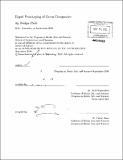Rapid prototyping of green composites
Author(s)
Peek, Nadya (Nadya Meile)
DownloadFull printable version (18.40Mb)
Other Contributors
Massachusetts Institute of Technology. Dept. of Architecture. Program in Media Arts and Sciences.
Advisor
Neil Gershenfeld.
Terms of use
Metadata
Show full item recordAbstract
Rapid prototyping employs digital fabrication techniques to quickly manufacture parts. However, the available materials are not yet suitable for making strong, large or durable objects. Composites are materials which are very strong and lightweight, combining the tensile strength of a fibre and the compressive strength of a resin matrix. Unfortunately, tooling for composite parts is currently expensive, slow to make, and therefore out of reach for many small-scale projects. Furthermore, popular composites are toxic to the environment and the people who work with them. Green-, eco- or bio- composites employ natural fibres in conjunction with biodegradable, renewably sourced or less toxic (in use and in manufacturing) matrices. Benefits of using natural fibre composites are that besides being light, strong and less toxic, they are also cheaper, of lower density, easier to work with and more environmentally friendly than carbon- or glass-fibre composites. The latest techniques and efforts on green composites however remain firmly in the lab- the resources evaluated are not readily accessible for manufacturing in the field. Local specialised projects now can use digital fabrication tools to realise structures previously considered prohibitively expensive to manufacture without an economy of scale. But because of the cost, difficulty and potential health hazards of composites, they have not yet been explored as a material for small scale local manufacturing. Digitally fabricated tooling introduces composite manufacturing as a rapid prototyping method. Green composites enable worker-safe manufacturing with environmentally friendly materials. Together, digitally fabricated tooling and green composite workflows allow faster, cheaper, stronger and less toxic large-scale prototyping in the field. I present an evaluation of green(er) composite materials which can be sourced and made in the field using low-cost digitally fabricated tooling. This includes case studies in medical devices, vehicles and housing.
Description
Thesis (S.M.)--Massachusetts Institute of Technology, School of Architecture and Planning, Program in Media Arts and Sciences, 2010. Cataloged from PDF version of thesis. Includes bibliographical references (p. 73-76).
Date issued
2010Department
Program in Media Arts and Sciences (Massachusetts Institute of Technology)Publisher
Massachusetts Institute of Technology
Keywords
Architecture. Program in Media Arts and Sciences.